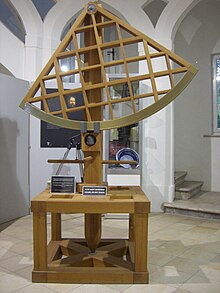Augsburg Quadrant
The Augsburg Quadrant was the first large precision instrument in recent astronomy history .
Paul Hainzel , a patrician , mayor and enthusiastic astronomer from Augsburg , had it built in early 1570 with the help of the astronomer Tycho Brahe (1546–1601).
The Augsburg Quadrant was made from solid oak and assembled according to Tycho Brahe's construction plans. The quadrant stood in the garden of Hainzel's estate in Augsburg-Göggingen on a hill and had a radius of about 6.4 meters. Various sources speak of a total height of 20 meters, but no information can be found in the letters and descriptions of Tycho Brahe, the actual height is likely to have been around 10 meters. The square base was dug into a bed of larger stones for stabilization so that it could withstand a storm. The quadrant probably didn't protrude more than eight to nine meters from the earth. To protect it from rain it was covered with a leather tarpaulin that could be pulled over the upper part with ropes. Tycho mentioned in his description that you had to use a ladder to sight deeper stars. With this instrument, the zenith distance and position of stars could be measured precisely. The accuracy of the quarter circle made of brass was up to then not reached 10 arc seconds .
With the quadrant, Hainzel was able to determine the latitude of his location to 48 degrees and 22 arc minutes in 1572, about two kilometers from the actual value. The exact position of the supernova of 1572 was also measured and published in Tycho Brahe's Astronomiae Instauratae Progymnasmata .
However, Brahe never took any measurements himself with the quadrant. At the time of completion, he had already left Augsburg for a long time. Despite being firmly anchored, the quadrant was destroyed in a strong storm in December 1574.
The quadrant was recreated according to the original plans by Tycho Brahe in 2006 (on a scale of 1: 5) and made available to the public as part of a permanent exhibition in Göggingen in the Römerturm , probably at the original location. The scale shown there with zigzag lines was only developed a few years later by Christoph Rothmann and Tycho Brahe and used, among other things, in the construction of Tycho's wall quadrant .
Individual evidence
- ^ John Louis Emil Dreyer: Tycho Brahe. A picture of scientific life and work in the sixteenth century Edinburgh 1890, p. 34
- ↑ Tycho Brahe: Astronomiae Instauratae Progymnasmata page 51
- ↑ Tycho Brahe: Astronomiae instauratae mechanica . Wandsbek 1598, "In radio ... ad minimum 14 cubitos"
- ↑ David Brewster: The martyrs of science; or, The lives of Galileo, Tycho Brahe, and Kepler New York 1841, 125
- ↑ Astronomiae Instauratae Progymnasmata, page 361


